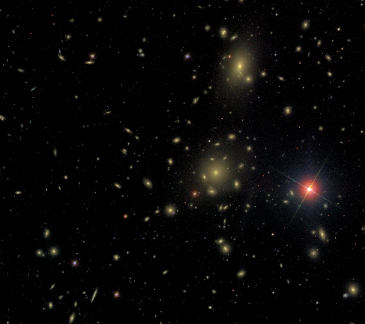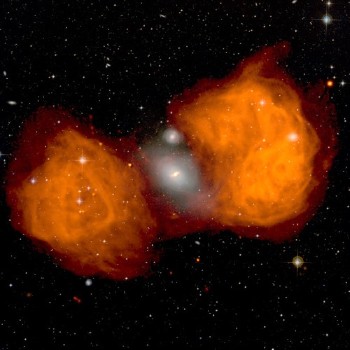This page unfortunately is a bit outdated; I've created a simple presentation of my current research interest here.
My research interests include clusters of galaxies, and the formation and evolution of galaxies.
clusters of galaxies
By clusters I actually mean galactic systems of significant mass -- say above 10^13 solar masses. These include groups and clusters of galaxies, although the division between the two is not very well-defined.
In any case, in such systems the dominant component in the dynamics is the dark matter, which may account for 80% of the total mass; about 15% is in the form of hot, ionized gas (known as the intracluster medium, or ICM); the rest is the stars, both in galaxies and in the intracluster space.
I'm keen in using clusters as a laboratory for studying galaxy evolution over cosmic time, as well as exploring the prospects of using clusters to probe cosmology.
evolution of galaxies in clusters

(the image on the right is taken from SDSS)
There have been lots of investigations of cluster galaxies, both in the local universe and at high-z. Using a moderate sample of ~90 clusters, Joe Mohr (Illinois, now LMU), Adam Stanford (UC Davis), and I, had examined some of the fundamental properties of clusters, such as the luminosity function (LF), spatial distribution of galaxies within clusters, and the scaling relations between cluster mass and the total number or luminosity of member galaxies (L-M and N-M relations). These properties tell us the relative importance of various processes (dynamical friction, mergers, ram pressure stripping, etc) in shaping the cluster galaxy population. The results are presented in these papers: Lin et al (2003), Lin et al (2004), and Lin & Mohr (2004) (together >550 citations so far!).
I plan to carry out such a comprehensive study at different epochs, so that we can better characterize the evolution of the cluster galaxies. A first attempt was presented in Lin et al (2006). Also see Ho et al (2009).
In a recent study using new data from WISE, I've found that the stellar mass content in clusters remains roughly constant (with respect to total cluster mass) up to z~0.6 or so. This is presented in Lin et al (2012).
Another powerful way is via the halo occupation distribution (HOD) analysis. Basically, one seeks ways to "populate" dark matter halos with galaxies so that the observed clustering properties (from <1 Mpc to >10 Mpc) can be reproduced. The best-fit HOD then provides some guidance on the N-M relation, the LF, and the spatial distribution of galaxies within clusters. I plan to apply such methodology to a wide field deep imaging survey carried out at the Subaru telescope, the Hyper Suprime Cam (HSC) project.
Yet another powerful technique to connect galaxies to dark matter halos/subhalos is subhalo abundance matching, which is pioneered in this paper. With Shogo Masaki and Naoshi Sugiyama of Nagoya University, and Naoki Yoshida of IPMU, I'm working on a project to explore how galaxies populate groups and clusters.
I have recently obtained high quality imaging data from Subaru Telescope over a special region of the sky (the so called "Bootes field"). I'll use these data to measure weak lensing signal of clusters and groups detected by Spitzer in this field. This will allow us to measure the L-M and N-M relationship up to z~1, and to estimate cosmological parameters at high redshift.
Sunyaev-Zel'dovich effect
The SZE is due to the inverse-Compton scattering between the hot electrons in the ICM and the photons from the cosmic microwave background (CMB). The net result is a distortion of the CMB energy spectrum; a cluster will appear as a decrement in the CMB intensity (a cold spot in the temperature map) below ~220 GHz, and an increment (hot spot) above that frequency. The beauty of this effect is its independence of cluster redshift -- in principle a cluster can be detected irrespective of its redshift, as long as it has sufficient amount of ICM!
Recognizing the potential of SZE to deliver a mass-selected cluster sample, and the constraining power on cosmology such a sample has, there are many SZE surveys currently underway: the Atacama Cosmology Telescope (ACT) project, which I'm involved, the South Pole Telescope project, AMiBA, APEX-SZ, AMI, SZA, and of course, Planck satellite.
Well-known methods for extracting cosmological information from clusters include their redshift distribution dN/dz, mass function as a function of redshift, and clustering (power spectrum). To make these happen, there are many pieces of information that need to be in place:
- cluster redshift -- at least photometric redshift from multiband optical/near-IR data is needed.
- cluster mass -- it's critical to know the SZE flux-cluster mass relation, where mass is preferably from weak lensing, again requiring high quality multiband optical/near-IR data.
- estimation of contamination from (unresolved) point sources, such as radio galaxies residing in clusters themselves (see e.g., Lin & Mohr 2007, Lin et al 2009, and Sehgal et al 2010), or dusty sub-millimeter galaxies at the background.
These aspects are my main interests in the ACT SZE survey: I have participated in the optical observations ("follow up") of the ACT survey regions, will help out in the calibration of the flux-mass relation, and have constructed a halo model of the radio sources in halos.
formation of elliptical galaxies
In the local universe, the most massive galaxies are ellipticals, and they are mainly located in dense environments such as clusters and groups. These galaxies have old stellar populations, and exhibit tight correlations between various physical properties such as the surface brightness, luminosity, and velocity dispersion. As I'll argue below, understanding their formation is critical to both cosmological model and galaxy formation in general.
importance of merger

(the image source is here)
For the very massive galaxies (say >5 times the mass of our galaxy), their evolution seems to proceed in an "anti-hierarchical" fashion. In the CDM paradigm, structure formation should proceed "bottom-up", namely the small objects merge to form larger, more massive ones. A naive reading of the CDM theory thus suggests that most massive galaxies should form last. However, many observations suggest that they have the oldest stellar populations, and they seem to be well assembled by redshift of one. However, as Faber et al (2007) argued, these observations not necessarily contradict the CDM theory, because at low redshifts what's forming is group-cluster scale halos, not galaxies anymore.
Nevertheless, there seems to be another problem with the most massive galaxies, the brightest cluster galaxies (BCGs) in clusters. In cosmological simulations the dark matter subhalos that correspond to BCGs typically experience many mergers at z<1. Therefore, if the merger history of stars follow that of the dark matter, the BCGs in the real world should exhibit strong signs of mergers. To my knowledge, there are not definitive observations confirming this yet. This is a direction that I would like to work on. With Jerry Ostriker (Princeton), we have published a paper on the evidence of mergers for the BCGs (Lin et al 2010a).
I'm currently developing a method to study galaxy populations (especially BCG) in clusters at different redshifts that are believed to form progenitor-descendant pairs, using the rich dataset available in Bootes field.
Recently it has been suggested that early type galaxies have grown a lot in size since z~2. It is likely that the size growth is due to minor mergers, and that these processes have preferentially added mass to the outskirts of the early type galaxies (see e.g., this paper). Using data from HSC, I plan to closely investigate this issue.
radio-loud AGN phenomenon

(the image source is here)
A non-negligible fraction of massive elliptical galaxies are active in the radio wavelengths. They emit jets and lobes of high energy particles into the intergalactic/intracluster medium; the electrons lose energy mainly via the synchrotron radiation. An example is shown on the right (NGC 1316, or Fornax A). The formation of the jets is one of the unsolved problems in astrophysics, and it seems the triggering of the radio active nucleus phenomenon has far reaching effects in the evolution of massive galaxies and their host halos.
One common problem faced by models of galaxy formation is gas cooling in dense regions, such as the cores of massive halos. As the bremsstrahlung luminosity is proportional to gas density squared, the ICM at the centers of halos are predicted to cool very rapidly and form new stars. However, the BCGs seldom are found hosting young stars. Something must be keeping gas hot. As radio lobes from radio galaxies (RGs) can affect their large scale environment, feedback from the radio-loud AGNs has been a popular way to prevent the "cooling flow" from happening.
With Michael Strauss (Princeton), Yue Shen (CfA), and Zheng Zheng (Utah), we have constructed a very large sample of nearby RGs (z<0.3), and used it to study the clustering properties and the bivariate radio and optical LFs of RGs. We also conducted an HOD analysis to better understand the relationship between RGs and their host halos, and the origin of the radio activity. The first results from this study, in which we proposed an objective way to classify RGs with extended radio morphology, and examined physical properties of various types of RGs, are presented in Lin et al (2010b).